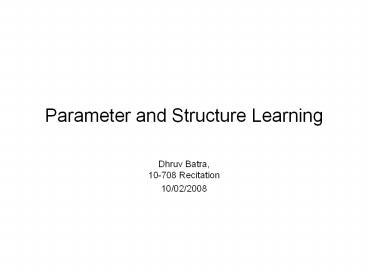Parameter and Structure Learning - PowerPoint PPT Presentation
Title:
Parameter and Structure Learning
Description:
TAN, Chow-Liu. HW2 implementation steps. Note. Plagiarism alert. Some s taken from others ... Chow-Liu. Score Based. Chow-Liu modification for TAN (HW2) ... – PowerPoint PPT presentation
Number of Views:27
Avg rating:3.0/5.0
Title: Parameter and Structure Learning
1
Parameter and Structure Learning
- Dhruv Batra,10-708 Recitation
- 10/02/2008
2
Overview
- Parameter Learning
- Classical view, estimation task
- Estimators, properties of estimators
- MLE, why MLE?
- MLE in BNs, decomposability
- Structure Learning
- Structure score, decomposable scores
- TAN, Chow-Liu
- HW2 implementation steps
3
Note
- Plagiarism alert
- Some slides taken from others
- Credits/references at the end
4
(No Transcript)
5
(No Transcript)
6
Parameter Learning
- Classical statistics view / Point Estimation
- Parameters unknown but not random
- Point estimation find the right parameter
- Estimate parameters (or functions of parameters)
of the model from data - Estimators
- Any statistic
- Function of data alone
- Say you have a dataset
- Need to estimate mean
- Is 5, an estimator?
- What would you do?
7
Properties of estimator
- Since estimator gives rise an estimate that
depends on sample points (x1,x2,,,xn) estimate is
a function of sample points. - Sample points are random variable therefore
estimate is random variable and has probability
distribution. - We want that estimator to have several desirable
properties like - Consistency
- Unbiasedness
- Minimum variance
- In general it is not possible for an estimator to
have all these properties.
8
(No Transcript)
9
(No Transcript)
10
(No Transcript)
11
(No Transcript)
12
So why MLE?
- MLE has some nice properties
- MLEs are often simple and easy to compute.
- MLEs have asymptotic optimality properties
(consistency and efficiency). - MLEs are invariant under reparameterization.
- and more..
13
Lets try
14
Back to BNs
- MLE in BN
- Data
- Model DAG G
- Parameters CPTs
- Learn parameters from data
15
Learning the CPTs
For each discrete variable Xi
Data
x(1) x(m)
16
Example
- Learning MLE parameters
17
Learning the CPTs
For each discrete variable Xi
Data
x(1) x(m)
18
Maximum likelihood estimation (MLE) of BN
parameters example
Flu
Allergy
Sinus
- Given structure, log likelihood of data
Nose
19
Decomposability
- Likelihood Decomposition
- Local likelihood function
Whats the difference?
Global parameter independence!
20
Taking derivatives of MLE of BN parameters
General case
21
Structure Learning
- Constraint Based
- Check independences, learn PDAG
- HW1
- Score Based
- Give a score for all possible structures
- Maximize score
22
Score Based
- Whats a good score function?
- How about our old friend, log likelihood?
- So heres our score function
23
Score Based
- Defn Decomposable scores
- Why do we care about decomposable scores?
- Log likelihood based score decomposes!
Need regularization
24
Score Based
- Chow-Liu
25
Score Based
- Chow-Liu modification for TAN (HW2)
26
Slide and other credits
- Zoubin Ghahramani, guest lectures in 10-702
- Andrew Moore tutorial
- http//www.autonlab.org/tutorials/mle.html
- http//cnx.org/content/m11446/latest/
- Lecture slides by Carlos Guestrin

